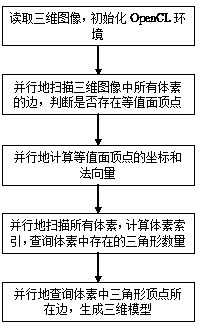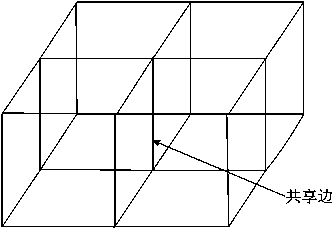OpenCL (Open Computing Language)-based marching cube method
A technology for moving cubes and voxels, which is applied in the field of 3D reconstruction and can solve problems such as data redundancy
- Summary
- Abstract
- Description
- Claims
- Application Information
AI Technical Summary
Problems solved by technology
Method used
Image
Examples
Embodiment Construction
[0050] The present invention will be further described in detail below in conjunction with the accompanying drawings and embodiments.
[0051] The mobile cube method is implemented based on OpenCL technology, and AMD Raedon HD 6850 GPU is selected as the OpenCL mobile device. In the moving cube method, the voxels are independent of each other when generating the 3D model, so the high concurrency of the GPU can be used to effectively shorten the running time. The edge of a voxel in a 3D image is actually shared by multiple adjacent voxels, such as figure 2 shown. In the existing OpenCL-based moving cube method, scanning voxels in parallel will repeatedly generate vertices existing on shared edges, resulting in data redundancy. The invention first scans the edges of voxels to generate isosurface vertices, then scans the voxels to generate isosurfaces, and eliminates redundant data on the premise of keeping the algorithm efficient.
[0052] like figure 1 As shown, an OpenCL-...
PUM
 Login to View More
Login to View More Abstract
Description
Claims
Application Information
 Login to View More
Login to View More - R&D
- Intellectual Property
- Life Sciences
- Materials
- Tech Scout
- Unparalleled Data Quality
- Higher Quality Content
- 60% Fewer Hallucinations
Browse by: Latest US Patents, China's latest patents, Technical Efficacy Thesaurus, Application Domain, Technology Topic, Popular Technical Reports.
© 2025 PatSnap. All rights reserved.Legal|Privacy policy|Modern Slavery Act Transparency Statement|Sitemap|About US| Contact US: help@patsnap.com


